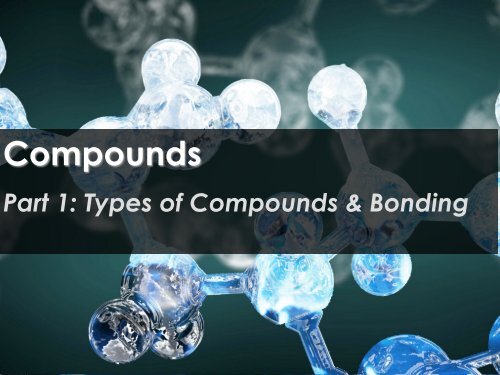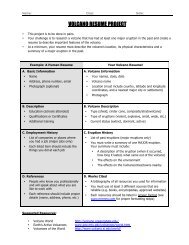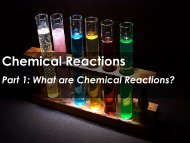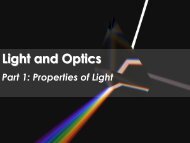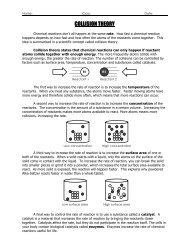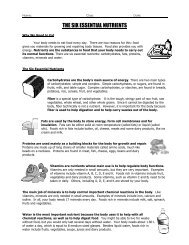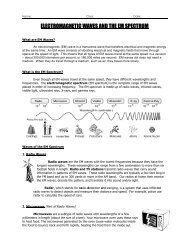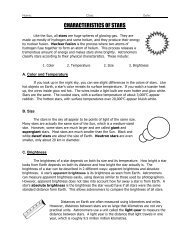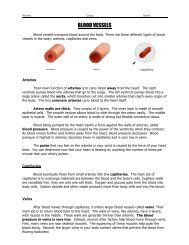Compounds - Science with Mr. Enns
Compounds - Science with Mr. Enns
Compounds - Science with Mr. Enns
Create successful ePaper yourself
Turn your PDF publications into a flip-book with our unique Google optimized e-Paper software.
<strong>Compounds</strong><br />
Part 1: Types of <strong>Compounds</strong> & Bonding
Review<br />
In their natural state, atoms have no overall charge.<br />
18<br />
Ar<br />
Argon<br />
40<br />
Protons = 18<br />
Electrons = 18<br />
This is because the number of protons (+)<br />
equals the number of electrons (-).
Review<br />
Electrons are found in shells around the nucleus.<br />
18<br />
Ar<br />
Argon<br />
40<br />
Shell 1 = 2 e -<br />
Shell 2 = 8 e -<br />
Shell 3 = 8 e - *<br />
Each shell holds a certain number of electrons.<br />
* For elements 1-20 only
Review<br />
Elements link together to form compounds.<br />
A compound is formed when two or<br />
more different elements bond together.<br />
hydrogen atom<br />
H<br />
O<br />
oxygen atom<br />
hydrogen atom<br />
H
Review<br />
Elements link together to form compounds.<br />
A compound is formed when two or<br />
more different elements bond together.<br />
H<br />
O<br />
H<br />
water molecule
Why <strong>Compounds</strong> Form<br />
Some elements never form compounds!<br />
2<br />
He<br />
Helium<br />
4<br />
8<br />
Ne<br />
Neon<br />
20<br />
18<br />
Ar<br />
Argon<br />
40<br />
Elements of the Noble Gases are unreactive. Why
Why <strong>Compounds</strong> Form<br />
Some elements never form compounds!<br />
He Ne Ar<br />
To understand why, we must look at the<br />
number of electrons in their outer shells.
Why <strong>Compounds</strong> Form<br />
A full outer shell makes atoms very stable.<br />
He Ne Ar<br />
2 e - 8 e -<br />
8 e -<br />
Full shell Full shell Full shell
Why <strong>Compounds</strong> Form<br />
All other atoms do NOT have a full outer shell!<br />
<strong>Compounds</strong> form because atoms want<br />
to achieve a full outer shell of electrons.<br />
Atoms can do this in one of two ways:<br />
Gaining<br />
Ionic<br />
or Losing<br />
<strong>Compounds</strong><br />
Electrons<br />
Covalent Sharing<br />
<strong>Compounds</strong><br />
Electrons
Ionic <strong>Compounds</strong><br />
Some atoms gain or lose electrons to get a full shell.<br />
An ion When is an they atom do <strong>with</strong> this, a they (+) form (-) ions. charge.<br />
+ ion<br />
- ion
Ionic <strong>Compounds</strong><br />
Some atoms gain or lose electrons to get a full shell.<br />
An ion When is an they atom do <strong>with</strong> this, a they (+) form (-) ions. charge.<br />
Full + ion shell!<br />
Full - ion shell!
Ionic <strong>Compounds</strong><br />
Some atoms gain or lose electrons to get a full shell.<br />
An ion When is an they atom do <strong>with</strong> this, a they (+) form (-) ions. charge.<br />
Na +1<br />
Cl -1<br />
Sodium chloride
Ionic <strong>Compounds</strong><br />
Ionic compounds are held together by ionic bonds.<br />
An An ion When ionic is an they bond atom do forms <strong>with</strong> this, a they as (+) a result form (-) ions. of charge. the<br />
attraction between (+) and (-) ions.<br />
Metals<br />
Lose e -<br />
Nonmetals<br />
Gain e -<br />
Ionic compounds always form<br />
between a metal and a nonmetal.
Another Example<br />
Mg reacts <strong>with</strong> F to form an ionic compound.<br />
Full<br />
Shell<br />
Full<br />
Shell<br />
Mg +2 F -1<br />
2 e -<br />
Full<br />
Shell F -1
Other Ionic <strong>Compounds</strong><br />
Fertilizer (K 3 N)<br />
Toothpaste fluoride (NaF)<br />
White M&M logo (TiO 2 )<br />
Bone minerals (CaO)
Review First!<br />
Most atoms do NOT have a full outer shell.<br />
<strong>Compounds</strong> form because atoms want<br />
to achieve a full outer shell of electrons.<br />
Atoms can do this in one of two ways:<br />
Gaining<br />
Ionic<br />
or Losing<br />
<strong>Compounds</strong><br />
Electrons<br />
Covalent Sharing<br />
<strong>Compounds</strong><br />
Electrons
Review First!<br />
Ionic compounds form between metals & nonmetals.<br />
Metals will LOSE electrons.<br />
Nonmetals will GAIN electrons.<br />
Metals lose e -<br />
since they have<br />
less than 4 electrons in<br />
their outer shells.<br />
Nonmetals gain e -<br />
since they have<br />
4 or more electrons<br />
in their outer shells.
Covalent <strong>Compounds</strong><br />
Covalent compounds form between nonmetals.<br />
Since nonmetals do NOT like to lose<br />
electrons, they share them instead.<br />
covalent bond<br />
Full<br />
Shell<br />
Full<br />
Shell<br />
Full<br />
Shell
Covalent Bonds<br />
Covalent compounds require covalent bonds.<br />
A covalent bond forms when two<br />
atoms share a pair of electrons.<br />
Atoms can share more than one pair of electrons:<br />
Double Two Pairs Bond<br />
Triple Three Bond Pairs
Covalent Bonds<br />
Covalent compounds require covalent bonds.<br />
Full<br />
Shell<br />
Full<br />
Shell<br />
Full<br />
Shell<br />
6 e - 4 e -<br />
6 e -<br />
carbon dioxide
Other Covalent <strong>Compounds</strong><br />
Methane (CH 4 )<br />
Hydrochloric acid (HCl)<br />
Rubbing alcohol (C 3 H 8 O)<br />
Glucose (C 6 H 12 O 6 )
Any Questions
<strong>Compounds</strong><br />
Part 2: Naming <strong>Compounds</strong>
1. Binary <strong>Compounds</strong><br />
Naming binary compounds involves simple rules.<br />
The name of the first element<br />
(usually a metal) stays the same.<br />
Change the name of second element<br />
(usually a nonmetal) so that it ends in “-ide”<br />
NaCl<br />
sodium chlorine chloride
Practice Questions<br />
LiCl<br />
lithium chloride<br />
MgS<br />
magnesium sulfide<br />
FeP<br />
iron phosphide
2. <strong>Compounds</strong> With Many Atoms<br />
Other compounds have more than two elements.<br />
The name of the first element<br />
(usually a metal) stays the same.<br />
You must add a prefix in front of the 2nd<br />
element when there is more than one atom.<br />
TiO 2<br />
titanium<br />
dioxide
Prefixes<br />
mono one<br />
penta five<br />
di two<br />
hexa six<br />
tri three<br />
hepta seven<br />
tetra four<br />
octa eight
Practice Questions<br />
CaCl 2<br />
calcium dichloride<br />
BeF 3<br />
beryllium trifluoride<br />
CCl 4<br />
carbon tetrachloride
3. <strong>Compounds</strong> With Polyatomic Ions<br />
Some compounds have feature groups of atoms<br />
that stay together and act as a single unit.<br />
These groups are called polyatomic ions.<br />
(meaning: many atoms and charged)<br />
For example…
Groups of Elements<br />
-CO 3<br />
“carbonate”<br />
CO 3
3. <strong>Compounds</strong> With Polyatomic Ions<br />
Some compounds have feature groups of atoms<br />
that stay together and act as a single unit.<br />
These groups are called polyatomic ions.<br />
(meaning: many atoms and charged)<br />
For example…<br />
When naming compounds <strong>with</strong> a polyatomic<br />
ion group, use its unique name at the end.
Groups of Elements<br />
MgCO 3<br />
Mg<br />
CO 3<br />
magnesium carbonate
Groups of Elements<br />
-CO 3<br />
carbonate<br />
- SO 4<br />
sulfate<br />
-PO 4<br />
phosphate<br />
-NO 3<br />
nitrate<br />
-HCO 3<br />
bicarbonate<br />
-OH hydroxide
Practice Questions<br />
CaPO 4<br />
calcium phosphate<br />
NaSO 4<br />
sodium sulfate<br />
KOH<br />
potassium hydroxide
Any Questions


